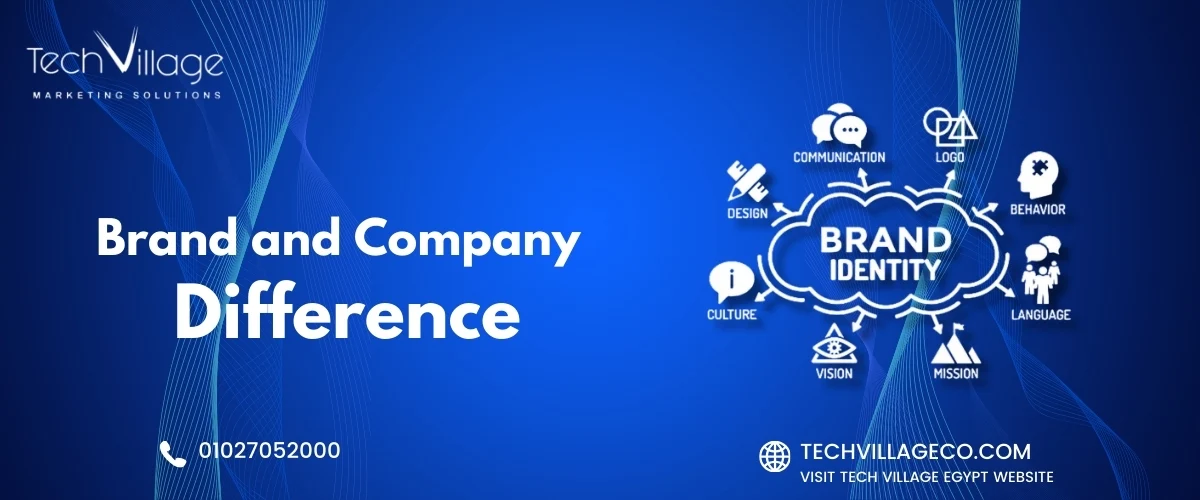Many people mistakenly use the terms “brand” and “company” interchangeably, assuming they mean the same thing. While a company and a brand are closely related, they serve distinct roles in the business world. so its important to know brand and company difference
A company is a legal business entity that produces goods or services, manages operations, and handles finances. In contrast, a brand is the identity, perception, and emotional connection that consumers associate with a product, service, or business.
Table of Contents
ToggleWhy is it important to know brand and company difference
✔ Branding Drives Customer Loyalty – Consumers connect with brands, not corporate entities.
✔ Companies Can Own Multiple Brands – A single company can operate several brands under one corporate structure (e.g., The Coca-Cola Company owns Sprite, Fanta, and Dasani).
✔ Stronger Branding Increases Business Value – A well-established brand can enhance a company’s market position, recognition, and profitability.
In this article, we’ll break down the key differences between a brand and a company, provide real-world examples, and explain why branding is a powerful tool for business success. 🚀
What is a Company?
On knowing brand and company difference, we gonna start with the company.
A company is a legal business entity that produces, sells, or distributes products and services. It exists as a formal structure that can operate under different business models, including sole proprietorships, partnerships, LLCs, and corporations. Unlike a brand, which is about identity and perception, a company is focused on operations, management, and financial activities.
Key Characteristics of a Company
✔ Legal Structure: A company is registered under a specific legal framework, such as:
- Sole Proprietorship – A single owner operates the business.
- Limited Liability Company (LLC) – Offers legal protection for owners while allowing operational flexibility.
- Corporation (Inc.) – A separate legal entity that can issue shares and operate independently of its owners.
✔ Business Operations: A company is responsible for manufacturing, marketing, sales, and logistics.
✔ Can Own Multiple Brands: A single company may oversee several brands under one corporate umbrella, each targeting different audiences with unique brand identities.
Examples of Well-Known Companies
✔ Procter & Gamble (P&G): A multinational corporation that owns well-known brands like Tide, Pampers, Gillette, and Olay. Each of these brands has its own unique identity, customer base, and marketing strategy, but they all operate under the P&G corporate structure.
✔ Alphabet Inc.: The parent company of Google, YouTube, Waymo (self-driving cars), and Fitbit. Alphabet provides corporate oversight and financial management, but each of its brands functions independently in the marketplace.
💡 Key Takeaway: A company is the foundation that manages business operations, while brands are the customer-facing identities that drive recognition, loyalty, and engagement. Up next, we’ll dive into what makes a brand unique from a company. 🚀
What is a Brand?
On knowing brand and company difference, we have the meaning of a brand now .
A brand is not just a name or a logo—it is the perception, reputation, and emotional connection that customers have with a product, service, or company. A strong brand influences how people think, feel, and interact with a business, shaping customer trust, loyalty, and purchasing decisions.
Key Characteristics of a Brand
✔ Visual Identity: A brand includes logos, colors, typography, and design elements that create a recognizable look and feel.
✔ Messaging & Values: A brand’s voice, tone, and core values define how it communicates with its audience.
✔ Customer Experience: The way a business engages, serves, and supports customers contributes to brand perception.
✔ Exists in the Minds of Consumers: Unlike a company, which is a legal entity, a brand is about public perception—it’s what customers think and feel when they hear the brand’s name.
✔ A Company Can Have Multiple Brands: A single company can operate different brands that cater to different markets and audiences.
Examples of Strong Brands
✔ Apple (Brand) vs. Apple Inc. (Company)
- Apple (Brand): Known for innovation, simplicity, and high-end technology. The brand evokes feelings of premium quality and exclusivity, which influences customer loyalty.
- Apple Inc. (Company): The business entity that manufactures and sells MacBooks, iPhones, and iPads while handling corporate strategy, supply chain, and operations.
✔ Nike (Brand) vs. Nike, Inc. (Company)
- Nike (Brand): Represents performance, inspiration, and motivation. Customers associate Nike with elite athletes, high-quality sportswear, and its iconic “Just Do It” slogan.
- Nike, Inc. (Company): The corporation behind the Nike brand, managing production, sales, and financial operations.
💡 Key Takeaway: A brand is how people feel about a business, while a company is the legal structure that runs it. Next, we’ll break down the key differences between a brand and a company to further clarify their unique roles. 🚀
Read also: Brand Identity Vs Brand Strategy.
Key Differences Between a Brand and a Company
While a brand and company difference is not that much and are closely connected, they serve different purposes in the business world. Below, we break down the key distinctions between them.
-
Legal Structure vs. Perception
✔ Company = A legal business entity
- A company is a registered business that owns assets, operates under government regulations, and manages financial and operational functions.
- Examples include LLCs, corporations, and sole proprietorships that manufacture and sell products or services.
✔ Brand = The emotional and market identity
- A brand is how consumers perceive and connect with a business. It includes logos, messaging, reputation, and customer experience.
- Unlike a company, a brand does not exist as a legal entity—it exists in the minds of consumers.
💡 Example: Tesla, Inc. is the company, while Tesla (the brand) represents innovation, sustainability, and futuristic electric vehicles in consumers’ minds.
-
Ownership and Multiple Brands
✔ A company can own multiple brands
- Large corporations often manage multiple brands, each targeting different customers.
- Example: The Coca-Cola Company owns Sprite, Fanta, Dasani, and Vitaminwater—each has its own branding and identity.
✔ A brand is specific to a product or service
- A brand can be sold or transferred to another company while keeping its identity intact.
- Example: The skincare brand The Body Shop was previously owned by L’Oréal but was sold to Natura & Co. The brand identity remained the same despite changing ownership.
- Function & Customer Interaction
✔ Company = Handles business operations
- Manages production, finances, supply chain, and corporate strategy.
- Deals with legal compliance, hiring, and investments.
✔ Brand = Shapes marketing and customer perception
- Creates brand awareness, emotional connections, and customer loyalty.
- Involves logos, slogans, advertising campaigns, and social media presence.
Get to know: Company Profile Design Services.
💡 Example:
- Nike, Inc. (Company) oversees manufacturing, partnerships, and global operations.
- Nike (Brand) is the face of the company, using branding strategies, marketing, and storytelling to connect with customers.
Why Branding Matters More Than Just a Company Name
Having a legally registered company is essential for business operations, but branding is what drives customer engagement, loyalty, and sales. A company can exist without a strong brand, but it will struggle to attract and retain customers. Below are key reasons why branding is more important than just having a company name.
-
Creates Customer Loyalty – People Connect with Brands, Not Companies
✔ Brands build emotional connections with consumers, making them more likely to return and recommend products or services.
✔ Customers don’t just buy products—they buy into the story, values, and identity of a brand.
✔ A well-defined brand fosters a sense of belonging and community among its audience.
💡 Example: Starbucks customers don’t just buy coffee—they engage with the Starbucks brand experience, from the cozy atmosphere to personalized cups and ethical sourcing initiatives.
-
Influences Buying Decisions – Consumers Choose Based on Brand Reputation, Not Corporate Ownership
✔ Many consumers don’t know or care which company owns a brand—what matters is the brand’s reputation.
✔ A strong brand creates trust and recognition, making customers more confident in their purchases.
✔ People are often willing to pay more for a brand they trust and resonate with.
💡 Example: Many consumers choose Ben & Jerry’s ice cream because they love the brand’s activism and storytelling, without realizing it’s owned by Unilever, a multinational corporation.
-
Adds Value – Strong Brands Increase a Company’s Market Worth
✔ A well-established brand can significantly increase a company’s valuation and attract investors.
✔ Brand recognition leads to premium pricing—customers will pay more for brands they perceive as high-quality or exclusive.
✔ According to Forbes’ Most Valuable Brands List, Apple’s brand alone is worth over $500 billion, contributing to its dominance in the tech industry.
💡 Example: Coca-Cola’s brand name alone is worth billions of dollars, proving that branding is a powerful business asset beyond just the company itself.
Get to know: types of brand management
Conclusion
Understanding brand and company difference is essential for business success. While a company is a legal business entity that manages operations, finances, and logistics, a brand is the identity, perception, and emotional connection that customers associate with the business.
Recap: Brand vs. Company Difference
✔ A company owns assets, produces goods or services, and operates within legal and financial structures.
✔ A brand represents the company’s identity, messaging, and customer experience.
✔ A single company can own multiple brands, each targeting different audiences.

 AR
AR




